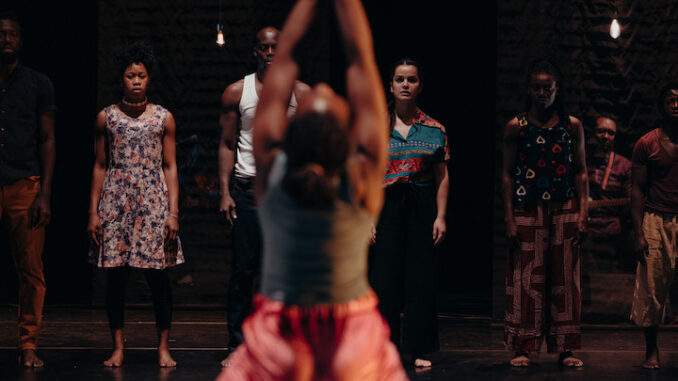
Liana Wilson-Graff
A powerful story, enriched with an abundance of symbols, intricate patterns, and specificity that startles, Once the dust settles, flowers bloom is something to sink your teeth into. This evening-length world of a piece choreographed by the accomplished Olivier Tarpaga, showcases music composed by the artist himself, performed by five musicians and vocalists, and seven dancers. In this new work, Tarpaga takes on the layered and deeply emotional subject of the refugee crisis in his home country of Burkina Faso, specifically the Sahel region. Dealing pointedly with the experience of women and children as they are forcibly removed from their homes, are faced with the religious extremism of jihadists, and a barrage of systematic and interpersonal violence, in Once the dust settles, flowers bloom, Tarpaga intends to settle the viewer into the resilience and beauty of these humans rather than the terror of what they must endure.
Tarpaga’s piece begins with a theatricality that depicts quite unsettling subject matter but serves to introduce the background of the piece. This sequence consists of a group of men, clearly characterized as the invading jihadists, hyping each other up with booming exclamations, and syncopated movements that feed into a frenzy of building, distinctly masculine, and dangerous energy. As they take up much of the stage, we see a woman downstage right, her head completely wrapped in black fabric, illuminated by a hanging lamp that lands just a few inches above her head. Her relaxed position in contrast to the craze of the men beside her, instills fear in all of us, and a sense of unsettlement because it is inevitable that some kind of physical force will be inflicted upon her. In a very danced way, the woman’s head covering is ripped off and she is sexually violated by one of the soldiers. Although this felt somewhat heavy-handed, it got the point across and dropped the audience right into the terms of this newly altered environment — the baseline is dangerous.
After this introduction, the theatricality of Once the dust settles, flowers bloom takes on a much smaller role, which is welcome as we begin to explore the subject matter through a more abstract lens into which dance provides a vital entryway. We are turned away from the extremists, inflicting violence and displacement, and turned towards the people of Burkina Faso, who must find a way to live, hope, and community as a people. The cast is made up of seven dancers, six of whom are black men and women, and one who is a white-looking woman, whose role appears to be distinct from the rest of the dancers and seems to have a different relationship to the unfolding crisis that is occurring throughout the piece, but it is unclear who she is, what her role in the narrative is, and what makes her different other than her appearance. This is something that I continue to think about in the grand scheme of the work and I think may have benefitted from further exploration or exposition.
What Once the dust settles, flowers bloom does with great effectiveness and intricacy is capture the idea of “gathering” as a profound and multifaceted term. “Gathering” is explored through the individual, in what it means to gather oneself emotionally and mentally, to gather your belongings, and gather as a people to move and continue to live in community. Dancers gather their own bodies in amazingly creative physical ways and gather each other as a complex moving body. There is joy and catharsis found in the gathering of the individual and the group. This is expressed through strong and masterfully articulated movements rippling through the body in ways that embrace contemporary and Africanist movement aesthetics with fervor. Moments where precise body articulation and gestures pull you into the details, repeated motifs of bigger movements, like throwing the body to the floor pull us back out into the world as it exists around the individual. The act of “gathering” really is what is most powerful about Tarpaga’s piece and what highlights its sense of hope. This, along with a diverse array of symbols manifested as props and set pieces — such as hundreds of flip flops moved by dancers in various physical and expressive forms, alongside the hanging lights adorning the stage manipulated by dancers, their glow reacting to the unfolding events — leaves you with the impression that a performance like this is something to contemplate for days, with thoughts about the work surprising you when you least expect it. Once the dust settles, flowers bloom is not something to attempt to understand, but to let envelop you as a literal moving world.
Olivier Tarpaga Dance Project’s, Once the dust settles, flowers bloom is presented by The Joyce Theater Foundation (Linda Shelton, Executive Director) and is playing at The Joyce Theater from October 3-8. Tickets, ranging in price from $12-$62 including fees, can be purchased at www.Joyce.org, or by calling JoyceCharge at 212-242-0800. Please note: ticket prices are subject to change. The Joyce Theater is located at 175 Eighth Avenue at West 19th Street. For more information, please visit www.Joyce.org.

Be the first to comment